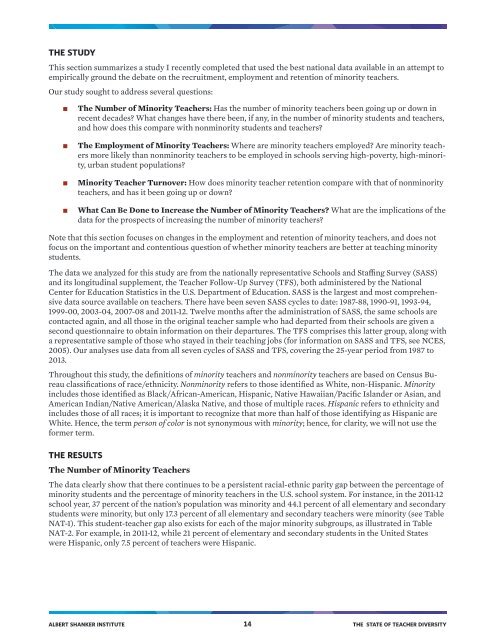TEACHER DIVERSITY
The State of Teacher Diversity_0
The State of Teacher Diversity_0
- No tags were found...
Create successful ePaper yourself
Turn your PDF publications into a flip-book with our unique Google optimized e-Paper software.
THE STUDY<br />
This section summarizes a study I recently completed that used the best national data available in an attempt to<br />
empirically ground the debate on the recruitment, employment and retention of minority teachers.<br />
Our study sought to address several questions:<br />
■■<br />
■■<br />
■■<br />
■■<br />
The Number of Minority Teachers: Has the number of minority teachers been going up or down in<br />
recent decades? What changes have there been, if any, in the number of minority students and teachers,<br />
and how does this compare with nonminority students and teachers?<br />
The Employment of Minority Teachers: Where are minority teachers employed? Are minority teachers<br />
more likely than nonminority teachers to be employed in schools serving high-poverty, high-minority,<br />
urban student populations?<br />
Minority Teacher Turnover: How does minority teacher retention compare with that of nonminority<br />
teachers, and has it been going up or down?<br />
What Can Be Done to Increase the Number of Minority Teachers? What are the implications of the<br />
data for the prospects of increasing the number of minority teachers?<br />
Note that this section focuses on changes in the employment and retention of minority teachers, and does not<br />
focus on the important and contentious question of whether minority teachers are better at teaching minority<br />
students.<br />
The data we analyzed for this study are from the nationally representative Schools and Staffing Survey (SASS)<br />
and its longitudinal supplement, the Teacher Follow-Up Survey (TFS), both administered by the National<br />
Center for Education Statistics in the U.S. Department of Education. SASS is the largest and most comprehensive<br />
data source available on teachers. There have been seven SASS cycles to date: 1987-88, 1990-91, 1993-94,<br />
1999-00, 2003-04, 2007-08 and 2011-12. Twelve months after the administration of SASS, the same schools are<br />
contacted again, and all those in the original teacher sample who had departed from their schools are given a<br />
second questionnaire to obtain information on their departures. The TFS comprises this latter group, along with<br />
a representative sample of those who stayed in their teaching jobs (for information on SASS and TFS, see NCES,<br />
2005). Our analyses use data from all seven cycles of SASS and TFS, covering the 25-year period from 1987 to<br />
2013.<br />
Throughout this study, the definitions of minority teachers and nonminority teachers are based on Census Bureau<br />
classifications of race/ethnicity. Nonminority refers to those identified as White, non-Hispanic. Minority<br />
includes those identified as Black/African-American, Hispanic, Native Hawaiian/Pacific Islander or Asian, and<br />
American Indian/Native American/Alaska Native, and those of multiple races. Hispanic refers to ethnicity and<br />
includes those of all races; it is important to recognize that more than half of those identifying as Hispanic are<br />
White. Hence, the term person of color is not synonymous with minority; hence, for clarity, we will not use the<br />
former term.<br />
THE RESULTS<br />
The Number of Minority Teachers<br />
The data clearly show that there continues to be a persistent racial-ethnic parity gap between the percentage of<br />
minority students and the percentage of minority teachers in the U.S. school system. For instance, in the 2011-12<br />
school year, 37 percent of the nation’s population was minority and 44.1 percent of all elementary and secondary<br />
students were minority, but only 17.3 percent of all elementary and secondary teachers were minority (see Table<br />
NAT-1). This student-teacher gap also exists for each of the major minority subgroups, as illustrated in Table<br />
NAT-2. For example, in 2011-12, while 21 percent of elementary and secondary students in the United States<br />
were Hispanic, only 7.5 percent of teachers were Hispanic.<br />
ALBERT SHANKER INSTITUTE 14 THE STATE OF <strong>TEACHER</strong> <strong>DIVERSITY</strong>


